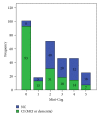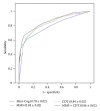Utility of the mini-cog for detection of cognitive impairment in primary care: data from two spanish studies
- PMID: 24069544
- PMCID: PMC3771448
- DOI: 10.1155/2013/285462
Utility of the mini-cog for detection of cognitive impairment in primary care: data from two spanish studies
Abstract
Objectives. To study the utility of the Mini-Cog test for detection of patients with cognitive impairment (CI) in primary care (PC). Methods. We pooled data from two phase III studies conducted in Spain. Patients with complaints or suspicion of CI were consecutively recruited by PC physicians. The cognitive diagnosis was performed by an expert neurologist, after formal neuropsychological evaluation. The Mini-Cog score was calculated post hoc, and its diagnostic utility was evaluated and compared with the utility of the Mini-Mental State (MMS), the Clock Drawing Test (CDT), and the sum of the MMS and the CDT (MMS + CDT) using the area under the receiver operating characteristic curve (AUC). The best cut points were obtained on the basis of diagnostic accuracy (DA) and kappa index. Results. A total sample of 307 subjects (176 CI) was analyzed. The Mini-Cog displayed an AUC (±SE) of 0.78 ± 0.02, which was significantly inferior to the AUC of the CDT (0.84 ± 0.02), the MMS (0.84 ± 0.02), and the MMS + CDT (0.86 ± 0.02). The best cut point of the Mini-Cog was 1/2 (sensitivity 0.60, specificity 0.90, DA 0.73, and kappa index 0.48 ± 0.05). Conclusions. The utility of the Mini-Cog for detection of CI in PC was very modest, clearly inferior to the MMS or the CDT. These results do not permit recommendation of the Mini-Cog in PC.
Figures


Similar articles
-
Assessment of the diagnostic accuracy and discriminative validity of the Clock Drawing and Mini-Cog tests in detecting cognitive impairment.Neurologia (Engl Ed). 2022 Jan-Feb;37(1):13-20. doi: 10.1016/j.nrleng.2018.12.022. Epub 2021 Sep 17. Neurologia (Engl Ed). 2022. PMID: 34538774
-
Assessment of the diagnostic accuracy and discriminative validity of the Clock Drawing and Mini-Cog tests in detecting cognitive impairment.Neurologia (Engl Ed). 2022 Jan-Feb;37(1):13-20. doi: 10.1016/j.nrl.2018.12.002. Epub 2019 Mar 5. Neurologia (Engl Ed). 2022. PMID: 30850258 English, Spanish.
-
[Effectiveness of the Mini-Mental State for detection of cognitive impairment in primary care].Aten Primaria. 2013 Oct;45(8):426-33. doi: 10.1016/j.aprim.2013.04.009. Epub 2013 Jul 17. Aten Primaria. 2013. PMID: 23870551 Free PMC article. Spanish.
-
Spanish-language screening scales: A critical review.Neurologia (Engl Ed). 2022 Jan-Feb;37(1):53-60. doi: 10.1016/j.nrl.2018.03.009. Epub 2018 May 9. Neurologia (Engl Ed). 2022. PMID: 29753565 Review. English, Spanish.
-
Is the Montreal Cognitive Assessment (MoCA) test better suited than the Mini-Mental State Examination (MMSE) in mild cognitive impairment (MCI) detection among people aged over 60? Meta-analysis.Psychiatr Pol. 2016 Oct 31;50(5):1039-1052. doi: 10.12740/PP/45368. Psychiatr Pol. 2016. PMID: 27992895 Review. English, Polish.
Cited by
-
A Community Program of Integrated Care for Frail Older Adults: +AGIL Barcelona.J Nutr Health Aging. 2019;23(8):710-716. doi: 10.1007/s12603-019-1244-4. J Nutr Health Aging. 2019. PMID: 31560028 Free PMC article.
-
Esophageal motility disorders in symptomatic patients and its relation to age.BMC Gastroenterol. 2023 Mar 11;23(1):69. doi: 10.1186/s12876-023-02709-3. BMC Gastroenterol. 2023. PMID: 36906548 Free PMC article.
-
Correlates to psychological distress in frail older community-dwellers undergoing lockdown during the COVID-19 pandemic.BMC Geriatr. 2022 Jun 23;22(1):516. doi: 10.1186/s12877-022-03072-w. BMC Geriatr. 2022. PMID: 35739478 Free PMC article.
-
Mini-Cog for the detection of dementia within a secondary care setting.Cochrane Database Syst Rev. 2021 Jul 14;7(7):CD011414. doi: 10.1002/14651858.CD011414.pub3. Cochrane Database Syst Rev. 2021. PMID: 34260060 Free PMC article.
-
Depressive Symptoms, Fatigue and Social Relationships Influenced Physical Activity in Frail Older Community-Dwellers during the Spanish Lockdown due to the COVID-19 Pandemic.Int J Environ Res Public Health. 2021 Jan 19;18(2):808. doi: 10.3390/ijerph18020808. Int J Environ Res Public Health. 2021. PMID: 33477879 Free PMC article.
References
-
- Luck T, Luppa M, Briel S, Riedel-Heller SG. Incidence of mild cognitive impairment: a systematic review. Dementia and Geriatric Cognitive Disorders. 2010;29(2):164–175. - PubMed
-
- Mitchell AJ, Shiri-Feshki M. Rate of progression of mild cognitive impairment to dementia—meta-analysis of 41 robust inception cohort studies. Acta Psychiatrica Scandinavica. 2009;119(4):252–265. - PubMed
LinkOut - more resources
Full Text Sources
Other Literature Sources

